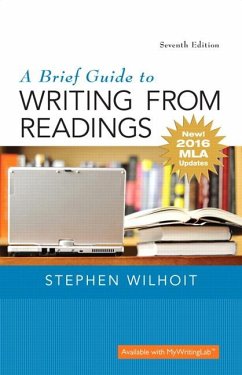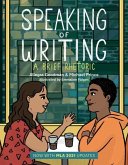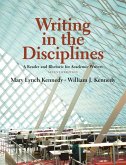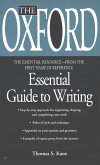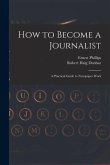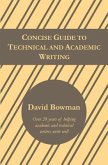Stephen Wilhoit
Brief Guide to Writing from Readings, A, MLA Update Edition
Stephen Wilhoit
Brief Guide to Writing from Readings, A, MLA Update Edition
- Broschiertes Buch
- Merkliste
- Auf die Merkliste
- Bewerten Bewerten
- Teilen
- Produkt teilen
- Produkterinnerung
- Produkterinnerung
For college courses in Writing Across the Curriculum (Composition) and Research Writing (Composition). This version of A Brief Guide to Writing from Readings has been updated the reflect the 8th edition of the MLA Handbook (April 2016). * Mastering the art of critical essay writing A Brief Guide to Writing from Readings is a clear, process-oriented guide to academic writing. The guide covers the subtleties of rhetorical analysis and argumentation strategies as well as the technical aspects of writing with sources. Students will learn first to examine texts critically and then to clearly,…mehr
Andere Kunden interessierten sich auch für
![Speaking of Writing: A Brief Rhetoric - With MLA 2021 Update Speaking of Writing: A Brief Rhetoric - With MLA 2021 Update]() Allegra GoodmanSpeaking of Writing: A Brief Rhetoric - With MLA 2021 Update46,99 €
Allegra GoodmanSpeaking of Writing: A Brief Rhetoric - With MLA 2021 Update46,99 €![A Short Guide to Writing about Psychology A Short Guide to Writing about Psychology]() Dana DunnA Short Guide to Writing about Psychology89,99 €
Dana DunnA Short Guide to Writing about Psychology89,99 €![Writing in the Disciplines Writing in the Disciplines]() Mary KennedyWriting in the Disciplines168,99 €
Mary KennedyWriting in the Disciplines168,99 €![The Oxford Essential Guide to Writing The Oxford Essential Guide to Writing]() Thomas S KaneThe Oxford Essential Guide to Writing9,49 €
Thomas S KaneThe Oxford Essential Guide to Writing9,49 €![History in Fiction; a Guide to the Best Historical Romances, Sagas, Novels, and Tales; 2 History in Fiction; a Guide to the Best Historical Romances, Sagas, Novels, and Tales; 2]() Ernest Albert BakerHistory in Fiction; a Guide to the Best Historical Romances, Sagas, Novels, and Tales; 222,99 €
Ernest Albert BakerHistory in Fiction; a Guide to the Best Historical Romances, Sagas, Novels, and Tales; 222,99 €![How to Become a Journalist: a Practical Guide to Newspaper Work How to Become a Journalist: a Practical Guide to Newspaper Work]() Ernest PhillipsHow to Become a Journalist: a Practical Guide to Newspaper Work20,99 €
Ernest PhillipsHow to Become a Journalist: a Practical Guide to Newspaper Work20,99 €![Concise Guide to Technical and Academic Writing Concise Guide to Technical and Academic Writing]() David BowmanConcise Guide to Technical and Academic Writing9,49 €
David BowmanConcise Guide to Technical and Academic Writing9,49 €-
-
-
For college courses in Writing Across the Curriculum (Composition) and Research Writing (Composition). This version of A Brief Guide to Writing from Readings has been updated the reflect the 8th edition of the MLA Handbook (April 2016). * Mastering the art of critical essay writing A Brief Guide to Writing from Readings is a clear, process-oriented guide to academic writing. The guide covers the subtleties of rhetorical analysis and argumentation strategies as well as the technical aspects of writing with sources. Students will learn first to examine texts critically and then to clearly, accurately and creatively respond in essay form. In-text tools including summary charts and revision checklists help students tackle source-based essays step by step. Instructors will rely on the guide as a one-stop reference tool; students can apply their learning to any discipline, whether for class work or independent study. In the Seventh Edition, in response to student and faculty feedback, Wilhoit includes a new chapter on analyzing readings and composing analytical essays; more coverage of literary analysis and a new short story; eight academic readings; and expanded coverage of how to cite electronic sources in APA and MLA style. *The 8th edition introduces sweeping changes to the philosophy and details of MLA works cited entries. Responding to the GÇ£increasing mobility of texts,GÇ¥ MLA now encourages writers to focus on the process of crafting the citation, beginning with the same questions for any source. These changes, then, align with current best practices in the teaching of writing which privilege inquiry and critical thinking over rote recall and rule-following.
Produktdetails
- Produktdetails
- Verlag: Pearson Education
- 7th edition
- Seitenzahl: 320
- Erscheinungstermin: 23. Juni 2016
- Englisch
- Abmessung: 226mm x 152mm x 13mm
- Gewicht: 318g
- ISBN-13: 9780134586557
- ISBN-10: 0134586557
- Artikelnr.: 44789384
- Herstellerkennzeichnung
- Libri GmbH
- Europaallee 1
- 36244 Bad Hersfeld
- gpsr@libri.de
- Verlag: Pearson Education
- 7th edition
- Seitenzahl: 320
- Erscheinungstermin: 23. Juni 2016
- Englisch
- Abmessung: 226mm x 152mm x 13mm
- Gewicht: 318g
- ISBN-13: 9780134586557
- ISBN-10: 0134586557
- Artikelnr.: 44789384
- Herstellerkennzeichnung
- Libri GmbH
- Europaallee 1
- 36244 Bad Hersfeld
- gpsr@libri.de
Table of Contents
1. Critical Reading
2. Definition and Purpose
3. Asking Questions about What You Read
o Questions to Ask Before You Begin a Close Reading of a Text
o Questions to Ask While You Read and Reread Material
4. Marking Texts
o Highlighting Texts
o Annotating Texts
5. Sample Annotated Reading: “Hard Choices,” by Patrick Moore
6. Note Taking
o Before Jotting Down Any Notes, Always Write Down the Source
Text’s Full Bibliographic Information
o In Your Notes, Carefully Distinguish between Material You Quote
and Material You Paraphrase
o Carefully List Page Numbers
o Pay Attention to the Punctuation in the Source Text
o In Your Notes, Clearly Differentiate between the Author’s Ideas
and Your Own
o Be Consistent with Your Note-Taking System
7. Additional Reading: “Getting Serious about Eradicating Binge
Drinking,” by Henry Wechsler
8. Summary Chart: Critical Reading: Asking Questions
9. Summary Chart: Critical Reading: Marking Texts
10. Summary Chart: Critical Reading: Note Taking
11. Quotation
12. Definition and Purpose
13. Guidelines on When to Quote Material
o Quote Passages When the Author Has Written Something in a
Distinctive or Especially Insightful or Interesting Way
o Quote Material That Lends Support to a Position You Are Trying
to Make in Your Paper
o Quote Authorities Who Disagree with a Position You Are
Advocating or Who Offer Alternative Explanations or
Contradictory Data
14. Guidelines on When Not to Quote Material
o Do Not Quote Passages Merely to Fill Space
o Do Not Quote Passages as a Substitute for Thinking
o Do Not Quote Passages Because You Do Not Understand the
Author’s Ideas Well Enough to Paraphrase Them
15. Integrating Quotations into Your Writing
o Two Basic Types of Quotations
16. Reading: “Generation Text,” by Mark Bauerlein
o The Block Quotation
o The Integrated Quotation
17. Altering Quoted Material and Avoiding Misquotations
18. Leaving Words Out of a Quotation
19. Adding Words to a Quotation
20. Noting Emphasis Added to a Quotation
21. Summary Chart: Guidelines on Quotations
22. Summary Chart: Integrating Quotations into Your Writing
23. Quotation Revision Checklist
24. Paraphrase
25. Definition and Purpose
26. Qualities of a Good Paraphrase
o Thorough
o Accurate
o Fair
o Objective
27. How to Paraphrase Material
o Changing Words
o Changing Sentence Structure
o Combining Sentences
o “Unpacking” Sentences
o Combining Strategies: Paraphrasing Longer Passages in Source
Texts
o Blending Your Writing with Paraphrased Material
28. Documentation
o Summary Chart: How to Paraphrase Material
o Paraphrase Revision Checklist
29. Summary
30. Definition and Purpose
31. Types of Summaries
32. Qualities of a Good Summary
o Comprehensive
o Brief
o Accurate
o Neutral
o Independent
33. How to Summarize a Text
o Read, Reread, and Annotate the Source Text
o Summarize Each Section of the Source Text
o Check the Section Summaries against the Source Text
34. How to Write an Abstract
35. How to Write an Informative Summary Essay
36. How to Write an Explanatory Summary Essay
37. Documentation
38. Reading: “From Animal House to Big Brother: Student Privacy and
Campus Safety in an Age of Accountability,” by Ron Chesbrough
o Sample Abstract
o Sample Informative Summary Essay
o Sample Explanatory Summary Essay
39. Summary Chart: How to Summarize Texts
40. Summary Revision Checklist
41. Analysis
42. Definition and Purpose
43. Reading: “The Story of an Hour,” by Kate Chopin
44. How to Analyze a Text
o Read the Source Text Carefully
o Identify or Choose Which Analytical Criteria to Employ
o Apply the Analytical Criteria to the Text
o Interpret the Text
o Explain and Support Your Interpretation
45. Qualities of a Good Analysis Essay
o Comprehensive
o Clear
o Consistent
o Tied to the Source Text
o Informative
46. How to Write an Analysis Essay
o Opening Section
o Body
o Concluding Section
47. Revising Your Essay
o Accuracy
o Development
o Clarity
o Balance
48. Documentation
49. Sample Analysis Essay
50. Summary Chart: How to Analyze Texts
51. Summary Chart: How to Write an Analysis Essay
52. Analysis Essay Checklist
53. Response Essays
54. Definition and Purpose
55. Qualities of a Good Response Essay
o Honest
o Informed
o Clear
o Well Supported
56. Writing the Response Essay
o Carefully Read the Material
o Compose Your Rough Draft
o Write Your Conclusion
o Revise Your Rough Draft
57. Sample Response Essay
58. A Response to “From Animal House to Big Brother: Student Privacy and
Campus Safety in an Age of Accountability”
59. Summary Chart: How to Write a Response Essay
60. Response Essay Revision Checklist
61. Critique
62. Definition and Purpose
63. The Film Review as Critique
64. Writing a Critique
o Step 1 -- Carefully Read and Annotate the Source Text
o Step 2 -- Analyze and Evaluate the Reading
o Step 3 -- Write Your Thesis and Decide Which Aspects of the
Reading Will Be the Focus of Your Essay
o Step 4 -- Write Your Rough Draft
o Step 5 -- Rewrite Your Critique
65. Reading: “The Doctrine of Academic Freedom,” by Sandra Y. L. Korn
66. Reading: “Academic Freedom vs. Academic Justice,” by Michael
LaBossiere
67. Sample Critique
68. “An Unconvincing Argument Concerning Academic Freedom”
69. Summary Chart: How to Write a Critique
70. Critique Revision Checklist
71. Rhetorical Analysis of Written Texts
72. Definition and Purpose
73. The Rhetorical Situation
o Elements of the Rhetorical Situation
74. Rhetorical Strategies
o Content
o Structure
o Style
75. Analyzing a Text’s Rhetorical Strategies -- An Example
o Lincoln’s Second Inaugural Address
o A Rhetorical Analysis of Lincoln’s Speech
76. Writing a Rhetorical Analysis Essay
o Step 1 -- Carefully Read the Assignment
o Step 2 -- Establish the Source Text’s Rhetorical Situation
o Step 3 -- Determine the Author’s Goal
o Step 4 -- Identify and Evaluate the Text’s Rhetorical
Strategies
o Step 5 -- Determine Your Thesis
o Step 6 -- Write Your Rough Draft
o Step 7 -- Revise Your Essay
77. Sample Rhetorical Analysis Essay
o Rhetorical Analysis of Lincoln’s Second Inaugural Address
78. Summary Chart: How to Write a Rhetorical Analysis Essay
79. Rhetorical Analysis of Written Texts Revision Checklist
80. Rhetorical Analysis of Visual Texts
81. Definition and Purpose
82. Reading Visual Texts Critically
o Questions Concerning the Visual Text Itself
o Questions Concerning the Visual Text’s Creator or Source
o Questions Concerning the Visual Text’s Purpose
o Questions Concerning the Visual Text’s Audience
o Questions Concerning Your Response to the Visual Text
83. Reading a Visual Text -- An Example
o Questions Concerning the Visual Text
o Questions Concerning the Visual Text’s Creator or Source
o Questions Concerning the Visual Text’s Purpose
o Questions Concerning the Visual Text’s Audience
o Questions Concerning Your Response to the Visual Text
84. Writing a Rhetorical Analysis of a Visual Text
o Step 1 -- Carefully Read the Assignment
o Step 2 -- Analyze and Describe the Text
o Step 3 -- Establish the Text’s Rhetorical Situation
o Step 4 -- Determine How the Text Attempts to Achieve Its
Rhetorical Goals
o Step 5 -- Determine Your Thesis
o Step 6 -- Write a Rough Draft
o Step 7 -- Revise Your Essay
85. Sample Rhetorical Analysis of a Visual Text
86. An Effective Advertisment for Literacy Support
87. Summary Chart: How to Write a Rhetorical Analysis of a Visual Text
88. Rhetorical Analysis of a Visual Text Revision Checklist
89. Informative Synthesis
90. Definition and Purpose
91. Types of Synthesis Essays
92. Reading: “Humanity 2.? Enhancement, Evolution and the Possible
Futures of Humanity,” by Sarah Chan
93. Reading: “On Designer Babies: Genetic Enhancement of Human Embryos Is
Not a Practice for Civil Societies,” by Sheldon Krimsky
94. Reading: “A Moderate Approach to Enhancement,” by Michael Selgelid
95. Informative Synthesis
o Definition
o Writing an Informative Synthesis
96. Sample Informative Synthesis
97. The Ethical Debate over Human Enhancement and Designer Babies
98. Summary Chart: How to Write an Informative Synthesis
99. Informative Synthesis Revision Checklist
100. Argumentative Synthesis
101. Definition and Purpose
102. The Elements of Argument
o Claims
o Grounds
o Warrants
103. Argument and Persuasion
o Appeals Based on Reason
o Appeals Based on Emotion
o Appeals Based on Character and Credibility
104. Writing an Argumentative Synthesis
o Step 1 -- Analyze the Assignment
o Step 2 -- Annotate and Critique the Readings
o Step 3 -- Formulate a Thesis
o Step 4 -- Choose an Organizational Plan
o Step 5 -- Write Your Rough Draft
o Step 6 -- Revise Your Draft
o Step 7 -- Check Quotations and Documentation
105. Sample Argumentative Synthesis
106. Make Human Enhancement Available to All
107. Additional Reading: “A New Definition of Leadership,” by Josh Misner
108. Additional Reading: “Understanding Your Leadership Balance,” by Lee
Ellis
109. Additional Reading: “A Question of Leadership,” by Gene Klann and
Talula Cartwright
110. Summary Chart: How to Write an Argumentative Synthesis
111. Argumentative Synthesis Revision Checklist
112. Plagiarism
113. Definition
114. Forms of Plagiarism
o Purchasing a Paper
o Turning in a Paper Someone Else Has Written for You
o Turning in Another Student’s Work without That Student’s
Knowledge
o Improper Collaboration
o Copying a Paper from a Source Text without Proper
Acknowledgment
o Cutting and Pasting Material from Sources
o Lifting Images from the Web or Other Sources
o Copying Statistics
o Copying Material from a Source Text, Supplying Proper
Documentation, but Leaving Out Quotation Marks
o Paraphrasing Material from a Reading without Proper
Documentation
o Self-Plagiarism
115. Why Students Plagiarize Work
116. How to Avoid Plagiarism
o Do Your Own Work
o Take Good Notes
o Paraphrase Properly
o Supply Proper Documentation
o Online Plagiarism Check
o Clarify Collaboration Guidelines
117. Summary Chart: Plagiarism
118. Plagiarism Checklist
119. Documentation
120. Definition and Purpose
121. Types of Documentation
122. Primary Academic Style Manuals
123. APA Guidelines
o In-Text Documentation
o Footnotes and Endnotes
124. MLA Guidelines
o In-Text Documentation
o Footnotes and Endnotes
125. Reference Lists and Works Cited Entries
126. Definition and Purpose
127. APA Format
o Sample Reference List Entries
o Sample APA-Style Reference List
128. MLA Format
o Sample Works Cited Entries
o Sample MLA-Style Works Cited List
1. Critical Reading
2. Definition and Purpose
3. Asking Questions about What You Read
o Questions to Ask Before You Begin a Close Reading of a Text
o Questions to Ask While You Read and Reread Material
4. Marking Texts
o Highlighting Texts
o Annotating Texts
5. Sample Annotated Reading: “Hard Choices,” by Patrick Moore
6. Note Taking
o Before Jotting Down Any Notes, Always Write Down the Source
Text’s Full Bibliographic Information
o In Your Notes, Carefully Distinguish between Material You Quote
and Material You Paraphrase
o Carefully List Page Numbers
o Pay Attention to the Punctuation in the Source Text
o In Your Notes, Clearly Differentiate between the Author’s Ideas
and Your Own
o Be Consistent with Your Note-Taking System
7. Additional Reading: “Getting Serious about Eradicating Binge
Drinking,” by Henry Wechsler
8. Summary Chart: Critical Reading: Asking Questions
9. Summary Chart: Critical Reading: Marking Texts
10. Summary Chart: Critical Reading: Note Taking
11. Quotation
12. Definition and Purpose
13. Guidelines on When to Quote Material
o Quote Passages When the Author Has Written Something in a
Distinctive or Especially Insightful or Interesting Way
o Quote Material That Lends Support to a Position You Are Trying
to Make in Your Paper
o Quote Authorities Who Disagree with a Position You Are
Advocating or Who Offer Alternative Explanations or
Contradictory Data
14. Guidelines on When Not to Quote Material
o Do Not Quote Passages Merely to Fill Space
o Do Not Quote Passages as a Substitute for Thinking
o Do Not Quote Passages Because You Do Not Understand the
Author’s Ideas Well Enough to Paraphrase Them
15. Integrating Quotations into Your Writing
o Two Basic Types of Quotations
16. Reading: “Generation Text,” by Mark Bauerlein
o The Block Quotation
o The Integrated Quotation
17. Altering Quoted Material and Avoiding Misquotations
18. Leaving Words Out of a Quotation
19. Adding Words to a Quotation
20. Noting Emphasis Added to a Quotation
21. Summary Chart: Guidelines on Quotations
22. Summary Chart: Integrating Quotations into Your Writing
23. Quotation Revision Checklist
24. Paraphrase
25. Definition and Purpose
26. Qualities of a Good Paraphrase
o Thorough
o Accurate
o Fair
o Objective
27. How to Paraphrase Material
o Changing Words
o Changing Sentence Structure
o Combining Sentences
o “Unpacking” Sentences
o Combining Strategies: Paraphrasing Longer Passages in Source
Texts
o Blending Your Writing with Paraphrased Material
28. Documentation
o Summary Chart: How to Paraphrase Material
o Paraphrase Revision Checklist
29. Summary
30. Definition and Purpose
31. Types of Summaries
32. Qualities of a Good Summary
o Comprehensive
o Brief
o Accurate
o Neutral
o Independent
33. How to Summarize a Text
o Read, Reread, and Annotate the Source Text
o Summarize Each Section of the Source Text
o Check the Section Summaries against the Source Text
34. How to Write an Abstract
35. How to Write an Informative Summary Essay
36. How to Write an Explanatory Summary Essay
37. Documentation
38. Reading: “From Animal House to Big Brother: Student Privacy and
Campus Safety in an Age of Accountability,” by Ron Chesbrough
o Sample Abstract
o Sample Informative Summary Essay
o Sample Explanatory Summary Essay
39. Summary Chart: How to Summarize Texts
40. Summary Revision Checklist
41. Analysis
42. Definition and Purpose
43. Reading: “The Story of an Hour,” by Kate Chopin
44. How to Analyze a Text
o Read the Source Text Carefully
o Identify or Choose Which Analytical Criteria to Employ
o Apply the Analytical Criteria to the Text
o Interpret the Text
o Explain and Support Your Interpretation
45. Qualities of a Good Analysis Essay
o Comprehensive
o Clear
o Consistent
o Tied to the Source Text
o Informative
46. How to Write an Analysis Essay
o Opening Section
o Body
o Concluding Section
47. Revising Your Essay
o Accuracy
o Development
o Clarity
o Balance
48. Documentation
49. Sample Analysis Essay
50. Summary Chart: How to Analyze Texts
51. Summary Chart: How to Write an Analysis Essay
52. Analysis Essay Checklist
53. Response Essays
54. Definition and Purpose
55. Qualities of a Good Response Essay
o Honest
o Informed
o Clear
o Well Supported
56. Writing the Response Essay
o Carefully Read the Material
o Compose Your Rough Draft
o Write Your Conclusion
o Revise Your Rough Draft
57. Sample Response Essay
58. A Response to “From Animal House to Big Brother: Student Privacy and
Campus Safety in an Age of Accountability”
59. Summary Chart: How to Write a Response Essay
60. Response Essay Revision Checklist
61. Critique
62. Definition and Purpose
63. The Film Review as Critique
64. Writing a Critique
o Step 1 -- Carefully Read and Annotate the Source Text
o Step 2 -- Analyze and Evaluate the Reading
o Step 3 -- Write Your Thesis and Decide Which Aspects of the
Reading Will Be the Focus of Your Essay
o Step 4 -- Write Your Rough Draft
o Step 5 -- Rewrite Your Critique
65. Reading: “The Doctrine of Academic Freedom,” by Sandra Y. L. Korn
66. Reading: “Academic Freedom vs. Academic Justice,” by Michael
LaBossiere
67. Sample Critique
68. “An Unconvincing Argument Concerning Academic Freedom”
69. Summary Chart: How to Write a Critique
70. Critique Revision Checklist
71. Rhetorical Analysis of Written Texts
72. Definition and Purpose
73. The Rhetorical Situation
o Elements of the Rhetorical Situation
74. Rhetorical Strategies
o Content
o Structure
o Style
75. Analyzing a Text’s Rhetorical Strategies -- An Example
o Lincoln’s Second Inaugural Address
o A Rhetorical Analysis of Lincoln’s Speech
76. Writing a Rhetorical Analysis Essay
o Step 1 -- Carefully Read the Assignment
o Step 2 -- Establish the Source Text’s Rhetorical Situation
o Step 3 -- Determine the Author’s Goal
o Step 4 -- Identify and Evaluate the Text’s Rhetorical
Strategies
o Step 5 -- Determine Your Thesis
o Step 6 -- Write Your Rough Draft
o Step 7 -- Revise Your Essay
77. Sample Rhetorical Analysis Essay
o Rhetorical Analysis of Lincoln’s Second Inaugural Address
78. Summary Chart: How to Write a Rhetorical Analysis Essay
79. Rhetorical Analysis of Written Texts Revision Checklist
80. Rhetorical Analysis of Visual Texts
81. Definition and Purpose
82. Reading Visual Texts Critically
o Questions Concerning the Visual Text Itself
o Questions Concerning the Visual Text’s Creator or Source
o Questions Concerning the Visual Text’s Purpose
o Questions Concerning the Visual Text’s Audience
o Questions Concerning Your Response to the Visual Text
83. Reading a Visual Text -- An Example
o Questions Concerning the Visual Text
o Questions Concerning the Visual Text’s Creator or Source
o Questions Concerning the Visual Text’s Purpose
o Questions Concerning the Visual Text’s Audience
o Questions Concerning Your Response to the Visual Text
84. Writing a Rhetorical Analysis of a Visual Text
o Step 1 -- Carefully Read the Assignment
o Step 2 -- Analyze and Describe the Text
o Step 3 -- Establish the Text’s Rhetorical Situation
o Step 4 -- Determine How the Text Attempts to Achieve Its
Rhetorical Goals
o Step 5 -- Determine Your Thesis
o Step 6 -- Write a Rough Draft
o Step 7 -- Revise Your Essay
85. Sample Rhetorical Analysis of a Visual Text
86. An Effective Advertisment for Literacy Support
87. Summary Chart: How to Write a Rhetorical Analysis of a Visual Text
88. Rhetorical Analysis of a Visual Text Revision Checklist
89. Informative Synthesis
90. Definition and Purpose
91. Types of Synthesis Essays
92. Reading: “Humanity 2.? Enhancement, Evolution and the Possible
Futures of Humanity,” by Sarah Chan
93. Reading: “On Designer Babies: Genetic Enhancement of Human Embryos Is
Not a Practice for Civil Societies,” by Sheldon Krimsky
94. Reading: “A Moderate Approach to Enhancement,” by Michael Selgelid
95. Informative Synthesis
o Definition
o Writing an Informative Synthesis
96. Sample Informative Synthesis
97. The Ethical Debate over Human Enhancement and Designer Babies
98. Summary Chart: How to Write an Informative Synthesis
99. Informative Synthesis Revision Checklist
100. Argumentative Synthesis
101. Definition and Purpose
102. The Elements of Argument
o Claims
o Grounds
o Warrants
103. Argument and Persuasion
o Appeals Based on Reason
o Appeals Based on Emotion
o Appeals Based on Character and Credibility
104. Writing an Argumentative Synthesis
o Step 1 -- Analyze the Assignment
o Step 2 -- Annotate and Critique the Readings
o Step 3 -- Formulate a Thesis
o Step 4 -- Choose an Organizational Plan
o Step 5 -- Write Your Rough Draft
o Step 6 -- Revise Your Draft
o Step 7 -- Check Quotations and Documentation
105. Sample Argumentative Synthesis
106. Make Human Enhancement Available to All
107. Additional Reading: “A New Definition of Leadership,” by Josh Misner
108. Additional Reading: “Understanding Your Leadership Balance,” by Lee
Ellis
109. Additional Reading: “A Question of Leadership,” by Gene Klann and
Talula Cartwright
110. Summary Chart: How to Write an Argumentative Synthesis
111. Argumentative Synthesis Revision Checklist
112. Plagiarism
113. Definition
114. Forms of Plagiarism
o Purchasing a Paper
o Turning in a Paper Someone Else Has Written for You
o Turning in Another Student’s Work without That Student’s
Knowledge
o Improper Collaboration
o Copying a Paper from a Source Text without Proper
Acknowledgment
o Cutting and Pasting Material from Sources
o Lifting Images from the Web or Other Sources
o Copying Statistics
o Copying Material from a Source Text, Supplying Proper
Documentation, but Leaving Out Quotation Marks
o Paraphrasing Material from a Reading without Proper
Documentation
o Self-Plagiarism
115. Why Students Plagiarize Work
116. How to Avoid Plagiarism
o Do Your Own Work
o Take Good Notes
o Paraphrase Properly
o Supply Proper Documentation
o Online Plagiarism Check
o Clarify Collaboration Guidelines
117. Summary Chart: Plagiarism
118. Plagiarism Checklist
119. Documentation
120. Definition and Purpose
121. Types of Documentation
122. Primary Academic Style Manuals
123. APA Guidelines
o In-Text Documentation
o Footnotes and Endnotes
124. MLA Guidelines
o In-Text Documentation
o Footnotes and Endnotes
125. Reference Lists and Works Cited Entries
126. Definition and Purpose
127. APA Format
o Sample Reference List Entries
o Sample APA-Style Reference List
128. MLA Format
o Sample Works Cited Entries
o Sample MLA-Style Works Cited List
Table of Contents
1. Critical Reading
2. Definition and Purpose
3. Asking Questions about What You Read
o Questions to Ask Before You Begin a Close Reading of a Text
o Questions to Ask While You Read and Reread Material
4. Marking Texts
o Highlighting Texts
o Annotating Texts
5. Sample Annotated Reading: “Hard Choices,” by Patrick Moore
6. Note Taking
o Before Jotting Down Any Notes, Always Write Down the Source
Text’s Full Bibliographic Information
o In Your Notes, Carefully Distinguish between Material You Quote
and Material You Paraphrase
o Carefully List Page Numbers
o Pay Attention to the Punctuation in the Source Text
o In Your Notes, Clearly Differentiate between the Author’s Ideas
and Your Own
o Be Consistent with Your Note-Taking System
7. Additional Reading: “Getting Serious about Eradicating Binge
Drinking,” by Henry Wechsler
8. Summary Chart: Critical Reading: Asking Questions
9. Summary Chart: Critical Reading: Marking Texts
10. Summary Chart: Critical Reading: Note Taking
11. Quotation
12. Definition and Purpose
13. Guidelines on When to Quote Material
o Quote Passages When the Author Has Written Something in a
Distinctive or Especially Insightful or Interesting Way
o Quote Material That Lends Support to a Position You Are Trying
to Make in Your Paper
o Quote Authorities Who Disagree with a Position You Are
Advocating or Who Offer Alternative Explanations or
Contradictory Data
14. Guidelines on When Not to Quote Material
o Do Not Quote Passages Merely to Fill Space
o Do Not Quote Passages as a Substitute for Thinking
o Do Not Quote Passages Because You Do Not Understand the
Author’s Ideas Well Enough to Paraphrase Them
15. Integrating Quotations into Your Writing
o Two Basic Types of Quotations
16. Reading: “Generation Text,” by Mark Bauerlein
o The Block Quotation
o The Integrated Quotation
17. Altering Quoted Material and Avoiding Misquotations
18. Leaving Words Out of a Quotation
19. Adding Words to a Quotation
20. Noting Emphasis Added to a Quotation
21. Summary Chart: Guidelines on Quotations
22. Summary Chart: Integrating Quotations into Your Writing
23. Quotation Revision Checklist
24. Paraphrase
25. Definition and Purpose
26. Qualities of a Good Paraphrase
o Thorough
o Accurate
o Fair
o Objective
27. How to Paraphrase Material
o Changing Words
o Changing Sentence Structure
o Combining Sentences
o “Unpacking” Sentences
o Combining Strategies: Paraphrasing Longer Passages in Source
Texts
o Blending Your Writing with Paraphrased Material
28. Documentation
o Summary Chart: How to Paraphrase Material
o Paraphrase Revision Checklist
29. Summary
30. Definition and Purpose
31. Types of Summaries
32. Qualities of a Good Summary
o Comprehensive
o Brief
o Accurate
o Neutral
o Independent
33. How to Summarize a Text
o Read, Reread, and Annotate the Source Text
o Summarize Each Section of the Source Text
o Check the Section Summaries against the Source Text
34. How to Write an Abstract
35. How to Write an Informative Summary Essay
36. How to Write an Explanatory Summary Essay
37. Documentation
38. Reading: “From Animal House to Big Brother: Student Privacy and
Campus Safety in an Age of Accountability,” by Ron Chesbrough
o Sample Abstract
o Sample Informative Summary Essay
o Sample Explanatory Summary Essay
39. Summary Chart: How to Summarize Texts
40. Summary Revision Checklist
41. Analysis
42. Definition and Purpose
43. Reading: “The Story of an Hour,” by Kate Chopin
44. How to Analyze a Text
o Read the Source Text Carefully
o Identify or Choose Which Analytical Criteria to Employ
o Apply the Analytical Criteria to the Text
o Interpret the Text
o Explain and Support Your Interpretation
45. Qualities of a Good Analysis Essay
o Comprehensive
o Clear
o Consistent
o Tied to the Source Text
o Informative
46. How to Write an Analysis Essay
o Opening Section
o Body
o Concluding Section
47. Revising Your Essay
o Accuracy
o Development
o Clarity
o Balance
48. Documentation
49. Sample Analysis Essay
50. Summary Chart: How to Analyze Texts
51. Summary Chart: How to Write an Analysis Essay
52. Analysis Essay Checklist
53. Response Essays
54. Definition and Purpose
55. Qualities of a Good Response Essay
o Honest
o Informed
o Clear
o Well Supported
56. Writing the Response Essay
o Carefully Read the Material
o Compose Your Rough Draft
o Write Your Conclusion
o Revise Your Rough Draft
57. Sample Response Essay
58. A Response to “From Animal House to Big Brother: Student Privacy and
Campus Safety in an Age of Accountability”
59. Summary Chart: How to Write a Response Essay
60. Response Essay Revision Checklist
61. Critique
62. Definition and Purpose
63. The Film Review as Critique
64. Writing a Critique
o Step 1 -- Carefully Read and Annotate the Source Text
o Step 2 -- Analyze and Evaluate the Reading
o Step 3 -- Write Your Thesis and Decide Which Aspects of the
Reading Will Be the Focus of Your Essay
o Step 4 -- Write Your Rough Draft
o Step 5 -- Rewrite Your Critique
65. Reading: “The Doctrine of Academic Freedom,” by Sandra Y. L. Korn
66. Reading: “Academic Freedom vs. Academic Justice,” by Michael
LaBossiere
67. Sample Critique
68. “An Unconvincing Argument Concerning Academic Freedom”
69. Summary Chart: How to Write a Critique
70. Critique Revision Checklist
71. Rhetorical Analysis of Written Texts
72. Definition and Purpose
73. The Rhetorical Situation
o Elements of the Rhetorical Situation
74. Rhetorical Strategies
o Content
o Structure
o Style
75. Analyzing a Text’s Rhetorical Strategies -- An Example
o Lincoln’s Second Inaugural Address
o A Rhetorical Analysis of Lincoln’s Speech
76. Writing a Rhetorical Analysis Essay
o Step 1 -- Carefully Read the Assignment
o Step 2 -- Establish the Source Text’s Rhetorical Situation
o Step 3 -- Determine the Author’s Goal
o Step 4 -- Identify and Evaluate the Text’s Rhetorical
Strategies
o Step 5 -- Determine Your Thesis
o Step 6 -- Write Your Rough Draft
o Step 7 -- Revise Your Essay
77. Sample Rhetorical Analysis Essay
o Rhetorical Analysis of Lincoln’s Second Inaugural Address
78. Summary Chart: How to Write a Rhetorical Analysis Essay
79. Rhetorical Analysis of Written Texts Revision Checklist
80. Rhetorical Analysis of Visual Texts
81. Definition and Purpose
82. Reading Visual Texts Critically
o Questions Concerning the Visual Text Itself
o Questions Concerning the Visual Text’s Creator or Source
o Questions Concerning the Visual Text’s Purpose
o Questions Concerning the Visual Text’s Audience
o Questions Concerning Your Response to the Visual Text
83. Reading a Visual Text -- An Example
o Questions Concerning the Visual Text
o Questions Concerning the Visual Text’s Creator or Source
o Questions Concerning the Visual Text’s Purpose
o Questions Concerning the Visual Text’s Audience
o Questions Concerning Your Response to the Visual Text
84. Writing a Rhetorical Analysis of a Visual Text
o Step 1 -- Carefully Read the Assignment
o Step 2 -- Analyze and Describe the Text
o Step 3 -- Establish the Text’s Rhetorical Situation
o Step 4 -- Determine How the Text Attempts to Achieve Its
Rhetorical Goals
o Step 5 -- Determine Your Thesis
o Step 6 -- Write a Rough Draft
o Step 7 -- Revise Your Essay
85. Sample Rhetorical Analysis of a Visual Text
86. An Effective Advertisment for Literacy Support
87. Summary Chart: How to Write a Rhetorical Analysis of a Visual Text
88. Rhetorical Analysis of a Visual Text Revision Checklist
89. Informative Synthesis
90. Definition and Purpose
91. Types of Synthesis Essays
92. Reading: “Humanity 2.? Enhancement, Evolution and the Possible
Futures of Humanity,” by Sarah Chan
93. Reading: “On Designer Babies: Genetic Enhancement of Human Embryos Is
Not a Practice for Civil Societies,” by Sheldon Krimsky
94. Reading: “A Moderate Approach to Enhancement,” by Michael Selgelid
95. Informative Synthesis
o Definition
o Writing an Informative Synthesis
96. Sample Informative Synthesis
97. The Ethical Debate over Human Enhancement and Designer Babies
98. Summary Chart: How to Write an Informative Synthesis
99. Informative Synthesis Revision Checklist
100. Argumentative Synthesis
101. Definition and Purpose
102. The Elements of Argument
o Claims
o Grounds
o Warrants
103. Argument and Persuasion
o Appeals Based on Reason
o Appeals Based on Emotion
o Appeals Based on Character and Credibility
104. Writing an Argumentative Synthesis
o Step 1 -- Analyze the Assignment
o Step 2 -- Annotate and Critique the Readings
o Step 3 -- Formulate a Thesis
o Step 4 -- Choose an Organizational Plan
o Step 5 -- Write Your Rough Draft
o Step 6 -- Revise Your Draft
o Step 7 -- Check Quotations and Documentation
105. Sample Argumentative Synthesis
106. Make Human Enhancement Available to All
107. Additional Reading: “A New Definition of Leadership,” by Josh Misner
108. Additional Reading: “Understanding Your Leadership Balance,” by Lee
Ellis
109. Additional Reading: “A Question of Leadership,” by Gene Klann and
Talula Cartwright
110. Summary Chart: How to Write an Argumentative Synthesis
111. Argumentative Synthesis Revision Checklist
112. Plagiarism
113. Definition
114. Forms of Plagiarism
o Purchasing a Paper
o Turning in a Paper Someone Else Has Written for You
o Turning in Another Student’s Work without That Student’s
Knowledge
o Improper Collaboration
o Copying a Paper from a Source Text without Proper
Acknowledgment
o Cutting and Pasting Material from Sources
o Lifting Images from the Web or Other Sources
o Copying Statistics
o Copying Material from a Source Text, Supplying Proper
Documentation, but Leaving Out Quotation Marks
o Paraphrasing Material from a Reading without Proper
Documentation
o Self-Plagiarism
115. Why Students Plagiarize Work
116. How to Avoid Plagiarism
o Do Your Own Work
o Take Good Notes
o Paraphrase Properly
o Supply Proper Documentation
o Online Plagiarism Check
o Clarify Collaboration Guidelines
117. Summary Chart: Plagiarism
118. Plagiarism Checklist
119. Documentation
120. Definition and Purpose
121. Types of Documentation
122. Primary Academic Style Manuals
123. APA Guidelines
o In-Text Documentation
o Footnotes and Endnotes
124. MLA Guidelines
o In-Text Documentation
o Footnotes and Endnotes
125. Reference Lists and Works Cited Entries
126. Definition and Purpose
127. APA Format
o Sample Reference List Entries
o Sample APA-Style Reference List
128. MLA Format
o Sample Works Cited Entries
o Sample MLA-Style Works Cited List
1. Critical Reading
2. Definition and Purpose
3. Asking Questions about What You Read
o Questions to Ask Before You Begin a Close Reading of a Text
o Questions to Ask While You Read and Reread Material
4. Marking Texts
o Highlighting Texts
o Annotating Texts
5. Sample Annotated Reading: “Hard Choices,” by Patrick Moore
6. Note Taking
o Before Jotting Down Any Notes, Always Write Down the Source
Text’s Full Bibliographic Information
o In Your Notes, Carefully Distinguish between Material You Quote
and Material You Paraphrase
o Carefully List Page Numbers
o Pay Attention to the Punctuation in the Source Text
o In Your Notes, Clearly Differentiate between the Author’s Ideas
and Your Own
o Be Consistent with Your Note-Taking System
7. Additional Reading: “Getting Serious about Eradicating Binge
Drinking,” by Henry Wechsler
8. Summary Chart: Critical Reading: Asking Questions
9. Summary Chart: Critical Reading: Marking Texts
10. Summary Chart: Critical Reading: Note Taking
11. Quotation
12. Definition and Purpose
13. Guidelines on When to Quote Material
o Quote Passages When the Author Has Written Something in a
Distinctive or Especially Insightful or Interesting Way
o Quote Material That Lends Support to a Position You Are Trying
to Make in Your Paper
o Quote Authorities Who Disagree with a Position You Are
Advocating or Who Offer Alternative Explanations or
Contradictory Data
14. Guidelines on When Not to Quote Material
o Do Not Quote Passages Merely to Fill Space
o Do Not Quote Passages as a Substitute for Thinking
o Do Not Quote Passages Because You Do Not Understand the
Author’s Ideas Well Enough to Paraphrase Them
15. Integrating Quotations into Your Writing
o Two Basic Types of Quotations
16. Reading: “Generation Text,” by Mark Bauerlein
o The Block Quotation
o The Integrated Quotation
17. Altering Quoted Material and Avoiding Misquotations
18. Leaving Words Out of a Quotation
19. Adding Words to a Quotation
20. Noting Emphasis Added to a Quotation
21. Summary Chart: Guidelines on Quotations
22. Summary Chart: Integrating Quotations into Your Writing
23. Quotation Revision Checklist
24. Paraphrase
25. Definition and Purpose
26. Qualities of a Good Paraphrase
o Thorough
o Accurate
o Fair
o Objective
27. How to Paraphrase Material
o Changing Words
o Changing Sentence Structure
o Combining Sentences
o “Unpacking” Sentences
o Combining Strategies: Paraphrasing Longer Passages in Source
Texts
o Blending Your Writing with Paraphrased Material
28. Documentation
o Summary Chart: How to Paraphrase Material
o Paraphrase Revision Checklist
29. Summary
30. Definition and Purpose
31. Types of Summaries
32. Qualities of a Good Summary
o Comprehensive
o Brief
o Accurate
o Neutral
o Independent
33. How to Summarize a Text
o Read, Reread, and Annotate the Source Text
o Summarize Each Section of the Source Text
o Check the Section Summaries against the Source Text
34. How to Write an Abstract
35. How to Write an Informative Summary Essay
36. How to Write an Explanatory Summary Essay
37. Documentation
38. Reading: “From Animal House to Big Brother: Student Privacy and
Campus Safety in an Age of Accountability,” by Ron Chesbrough
o Sample Abstract
o Sample Informative Summary Essay
o Sample Explanatory Summary Essay
39. Summary Chart: How to Summarize Texts
40. Summary Revision Checklist
41. Analysis
42. Definition and Purpose
43. Reading: “The Story of an Hour,” by Kate Chopin
44. How to Analyze a Text
o Read the Source Text Carefully
o Identify or Choose Which Analytical Criteria to Employ
o Apply the Analytical Criteria to the Text
o Interpret the Text
o Explain and Support Your Interpretation
45. Qualities of a Good Analysis Essay
o Comprehensive
o Clear
o Consistent
o Tied to the Source Text
o Informative
46. How to Write an Analysis Essay
o Opening Section
o Body
o Concluding Section
47. Revising Your Essay
o Accuracy
o Development
o Clarity
o Balance
48. Documentation
49. Sample Analysis Essay
50. Summary Chart: How to Analyze Texts
51. Summary Chart: How to Write an Analysis Essay
52. Analysis Essay Checklist
53. Response Essays
54. Definition and Purpose
55. Qualities of a Good Response Essay
o Honest
o Informed
o Clear
o Well Supported
56. Writing the Response Essay
o Carefully Read the Material
o Compose Your Rough Draft
o Write Your Conclusion
o Revise Your Rough Draft
57. Sample Response Essay
58. A Response to “From Animal House to Big Brother: Student Privacy and
Campus Safety in an Age of Accountability”
59. Summary Chart: How to Write a Response Essay
60. Response Essay Revision Checklist
61. Critique
62. Definition and Purpose
63. The Film Review as Critique
64. Writing a Critique
o Step 1 -- Carefully Read and Annotate the Source Text
o Step 2 -- Analyze and Evaluate the Reading
o Step 3 -- Write Your Thesis and Decide Which Aspects of the
Reading Will Be the Focus of Your Essay
o Step 4 -- Write Your Rough Draft
o Step 5 -- Rewrite Your Critique
65. Reading: “The Doctrine of Academic Freedom,” by Sandra Y. L. Korn
66. Reading: “Academic Freedom vs. Academic Justice,” by Michael
LaBossiere
67. Sample Critique
68. “An Unconvincing Argument Concerning Academic Freedom”
69. Summary Chart: How to Write a Critique
70. Critique Revision Checklist
71. Rhetorical Analysis of Written Texts
72. Definition and Purpose
73. The Rhetorical Situation
o Elements of the Rhetorical Situation
74. Rhetorical Strategies
o Content
o Structure
o Style
75. Analyzing a Text’s Rhetorical Strategies -- An Example
o Lincoln’s Second Inaugural Address
o A Rhetorical Analysis of Lincoln’s Speech
76. Writing a Rhetorical Analysis Essay
o Step 1 -- Carefully Read the Assignment
o Step 2 -- Establish the Source Text’s Rhetorical Situation
o Step 3 -- Determine the Author’s Goal
o Step 4 -- Identify and Evaluate the Text’s Rhetorical
Strategies
o Step 5 -- Determine Your Thesis
o Step 6 -- Write Your Rough Draft
o Step 7 -- Revise Your Essay
77. Sample Rhetorical Analysis Essay
o Rhetorical Analysis of Lincoln’s Second Inaugural Address
78. Summary Chart: How to Write a Rhetorical Analysis Essay
79. Rhetorical Analysis of Written Texts Revision Checklist
80. Rhetorical Analysis of Visual Texts
81. Definition and Purpose
82. Reading Visual Texts Critically
o Questions Concerning the Visual Text Itself
o Questions Concerning the Visual Text’s Creator or Source
o Questions Concerning the Visual Text’s Purpose
o Questions Concerning the Visual Text’s Audience
o Questions Concerning Your Response to the Visual Text
83. Reading a Visual Text -- An Example
o Questions Concerning the Visual Text
o Questions Concerning the Visual Text’s Creator or Source
o Questions Concerning the Visual Text’s Purpose
o Questions Concerning the Visual Text’s Audience
o Questions Concerning Your Response to the Visual Text
84. Writing a Rhetorical Analysis of a Visual Text
o Step 1 -- Carefully Read the Assignment
o Step 2 -- Analyze and Describe the Text
o Step 3 -- Establish the Text’s Rhetorical Situation
o Step 4 -- Determine How the Text Attempts to Achieve Its
Rhetorical Goals
o Step 5 -- Determine Your Thesis
o Step 6 -- Write a Rough Draft
o Step 7 -- Revise Your Essay
85. Sample Rhetorical Analysis of a Visual Text
86. An Effective Advertisment for Literacy Support
87. Summary Chart: How to Write a Rhetorical Analysis of a Visual Text
88. Rhetorical Analysis of a Visual Text Revision Checklist
89. Informative Synthesis
90. Definition and Purpose
91. Types of Synthesis Essays
92. Reading: “Humanity 2.? Enhancement, Evolution and the Possible
Futures of Humanity,” by Sarah Chan
93. Reading: “On Designer Babies: Genetic Enhancement of Human Embryos Is
Not a Practice for Civil Societies,” by Sheldon Krimsky
94. Reading: “A Moderate Approach to Enhancement,” by Michael Selgelid
95. Informative Synthesis
o Definition
o Writing an Informative Synthesis
96. Sample Informative Synthesis
97. The Ethical Debate over Human Enhancement and Designer Babies
98. Summary Chart: How to Write an Informative Synthesis
99. Informative Synthesis Revision Checklist
100. Argumentative Synthesis
101. Definition and Purpose
102. The Elements of Argument
o Claims
o Grounds
o Warrants
103. Argument and Persuasion
o Appeals Based on Reason
o Appeals Based on Emotion
o Appeals Based on Character and Credibility
104. Writing an Argumentative Synthesis
o Step 1 -- Analyze the Assignment
o Step 2 -- Annotate and Critique the Readings
o Step 3 -- Formulate a Thesis
o Step 4 -- Choose an Organizational Plan
o Step 5 -- Write Your Rough Draft
o Step 6 -- Revise Your Draft
o Step 7 -- Check Quotations and Documentation
105. Sample Argumentative Synthesis
106. Make Human Enhancement Available to All
107. Additional Reading: “A New Definition of Leadership,” by Josh Misner
108. Additional Reading: “Understanding Your Leadership Balance,” by Lee
Ellis
109. Additional Reading: “A Question of Leadership,” by Gene Klann and
Talula Cartwright
110. Summary Chart: How to Write an Argumentative Synthesis
111. Argumentative Synthesis Revision Checklist
112. Plagiarism
113. Definition
114. Forms of Plagiarism
o Purchasing a Paper
o Turning in a Paper Someone Else Has Written for You
o Turning in Another Student’s Work without That Student’s
Knowledge
o Improper Collaboration
o Copying a Paper from a Source Text without Proper
Acknowledgment
o Cutting and Pasting Material from Sources
o Lifting Images from the Web or Other Sources
o Copying Statistics
o Copying Material from a Source Text, Supplying Proper
Documentation, but Leaving Out Quotation Marks
o Paraphrasing Material from a Reading without Proper
Documentation
o Self-Plagiarism
115. Why Students Plagiarize Work
116. How to Avoid Plagiarism
o Do Your Own Work
o Take Good Notes
o Paraphrase Properly
o Supply Proper Documentation
o Online Plagiarism Check
o Clarify Collaboration Guidelines
117. Summary Chart: Plagiarism
118. Plagiarism Checklist
119. Documentation
120. Definition and Purpose
121. Types of Documentation
122. Primary Academic Style Manuals
123. APA Guidelines
o In-Text Documentation
o Footnotes and Endnotes
124. MLA Guidelines
o In-Text Documentation
o Footnotes and Endnotes
125. Reference Lists and Works Cited Entries
126. Definition and Purpose
127. APA Format
o Sample Reference List Entries
o Sample APA-Style Reference List
128. MLA Format
o Sample Works Cited Entries
o Sample MLA-Style Works Cited List

